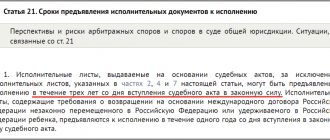Home / Alimony / Procedure for revoking a writ of execution for alimony
Collection of alimony from the debtor always occurs on the basis of a writ of execution submitted to the bailiffs. As long as this document is in the FSSP, officials monitor the proper implementation of transfers in favor of the recipient, however, debtors often offer collectors to take the IL in exchange for an increase in the amount of payments. Read on to find out whether you should be afraid of this and what such a scheme may entail.
What is a writ of execution for alimony
A writ of execution for alimony is an official document with legal force, on the basis of which the plaintiff has the opportunity to initiate a procedure for the forced collection of money for a minor child through the FSSP.
As practice shows, parents who are obliged to pay child support by court decision quite often try to evade this obligation. To have an effective influence on the debtor, the plaintiff must seek help from the bailiffs. In this case, you will definitely need to first obtain a writ of execution.
REFERENCE. IL for alimony can be transferred not only to the FSSP. This document can also be taken to the organization where the debtor works. In this case, appropriate deductions will be made from the latter’s salary.
The role of bailiffs
To talk about what role bailiffs play in enforcement proceedings, it is worth understanding the issue of their actions. Thus, during the period of collection of alimony payments, bailiffs perform all actions aimed at ensuring that citizens fulfill their duties in good faith.
- At the initial stage, when submitting a writ of execution, the bailiff issues a resolution to begin work on collecting payments. The production period for the writ of execution is 3 days. The paper contains information about the amount of cash payments, the existence of debt, and also indicates the requirement to comply with the law imposed on the debtor.
- Next, the executor finds out where the debtor lives and officially works. In addition, there is a need to carry out work that would reveal the availability of additional income for the debtor. Information about the property is also collected. If a violation is established on the part of the enterprise where the debtor works, then the chief accountant and manager of the enterprise are held accountable.
- It happens that the debtor does not provide any information about his income. Then the bailiff takes as a basis the average earnings in the debtor’s region of residence and, taking this information into account, calculates the required amount.
- If the whereabouts of the debtor are unknown, the bailiff can organize efforts to find him.
- If there is a debt, the bailiff can sell the debtor's property through auction.
- The bailiff may apply to the court with a request to bring to criminal liability a debtor who has a significant debt in payments.
Is it possible to revoke a writ of execution for alimony?
In accordance with paragraphs. 1) clause 1) art. 46 of the Federal Law of the Russian Federation “On Enforcement Proceedings”, one of the grounds for revoking the IL, including alimony, may be the personal initiative of the claimant. In this case, he will be the parent with whom the minor remains to live.
Thus, it seems possible to revoke the writ of execution for alimony. But here some features must be taken into account:
- for this purpose, there must be a written consent of the claimant (in the format of an application),
- revocation of the IL occurs when the parties manage to peacefully agree on the provision of financial support for a common child,
- after the return of this document, enforcement proceedings are completed, but they can be resumed,
- revocation of the IL does not relieve the obligation to pay alimony.
Reasons for revoking a writ of execution for alimony
In practice, there are quite different reasons for the revocation of IP. The most common include:
- The parties intend to independently resolve the issue of paying alimony without the participation of bailiffs. This is especially beneficial in the case when the payer receives unofficial income. It is possible to agree on an amount greater than the amount assigned by the court,
- a settlement agreement was concluded between former spouses who have a common child,
- the parent living with the child is not interested in receiving payments from his former spouse due to his good financial situation,
- the parties agreed to transfer the property of the child into the ownership of the child (for the payment of alimony),
- the father (mother) transferred a large sum of money at a time to support the common child,
- the person obligated to pay alimony is experiencing temporary financial difficulties, so the other party made concessions and decided to withdraw the writ of execution,
- other reasons.
ATTENTION. It should be borne in mind that according to the law, the second parent (with whom the child lives) cannot refuse child support payments, since the actual recipient of these funds is a minor.
Why might a recipient of alimony need to obtain a writ of execution?
Based on the above list of possible reasons for revoking a writ of execution, we can conclude that such a need may arise under the following conditions:
- the parties managed to reach an agreement on the payment of alimony,
- the debtor offered more favorable terms for child support,
- the revocation of the IL was carried out on a reimbursable basis (for example, in exchange for obtaining permission from the father for the child to travel abroad).
What documents will be required?
If the application is submitted by the claimant, it is required to confirm the renewal of the relationship with a marriage certificate, a drawn up settlement agreement certified by a notary (it indicates the monthly amount for the maintenance of a minor), an agreement on the payment of a large sum or the purchase of an expensive item.
If the document is sent by the alimony payer, evidence of insolvency, difficult financial situation, being on a long business trip or military service is attached.
There is no need to pay a state fee for filing an application.
How to pick up a writ of execution for alimony from the bailiffs
The procedure for revoking a writ of execution is described in Art. 46-47 Federal Law of the Russian Federation “On enforcement proceedings. It includes several simple steps:
- Preparation of the relevant application and collection of documents.
- Submission of a complete package of documents to the FSSP.
- Checking the application by the bailiff and issuing a ruling on the completion of enforcement proceedings and the return of the IP.
- Delivery of the decision to the applicant.
Rules for revoking a writ of execution
When planning to revoke a writ of execution, the claimant and the debtor must remember the following conditions for such a procedure:
- termination of enforcement proceedings does not relieve the father (mother) from paying alimony. The need to provide financial support for a child remains until he reaches the age of 18 years,
- payments made outside of enforcement proceedings should not be less than the amounts assigned by the court, since in this case the provisions of paragraph 2 of Art. 103 IC RF,
- If the alimony payer violates the terms of the agreement reached with the claimant, the latter has the right at any time to resume the procedure for forced collection of money through the bailiffs.
Procedure for revoking a writ of execution from bailiffs
In general, the procedure for revoking a writ of execution can be presented in the format of the following step-by-step instructions:
- Step 1 – contact the FSSP. To do this, you need to first prepare an application in any form and collect the necessary documents.
- Step 2 - the next step is to wait until the verification of the submitted application is completed. If a positive decision is made, the bailiff will prepare a resolution to end the enforcement proceedings and return the IL to the applicant.
- Step 3 – at this stage the writ of execution is returned to the claimant. In addition, the applicant must also be sent a copy of the relevant resolution (clause 6 of Article 47 of the Federal Law of the Russian Federation “On Enforcement Proceedings”).
REFERENCE. In accordance with paragraph 4 of Art. 45 of the Federal Law of the Russian Federation “On Enforcement Proceedings”, the bailiff must consider the application for revocation of the IL and prepare a corresponding resolution within 3 working days.
Where to go and procedure
According to the general rule, in order to revoke the IL, the claimant must submit an application to the territorial branch of the FSSP, where the forced procedure for collecting alimony was initiated. You can do this in several ways:
- personal visit,
- transfer through a representative,
- direction by mail,
- online through the Internet reception.
In practice, other situations are possible. For example, if the sheet was originally transferred to the debtor’s employer, then you need to apply for its return to the accounting service of this organization.
What documents will be required?
When filing a revocation of the IL, in addition to the application prepared by the claimant, the bailiff may also request other documents confirming the amicable resolution of the alimony issue. These can be the following types of papers:
Dear readers ! To solve exactly your problem, contact our online consultant on the website. It's free. For any region.
Dear readers ! To solve exactly your problem, contact our online consultant on the website. It's free. For any region.
- settlement agreement concluded with the debtor,
- certificate of remarriage with the same spouse,
- deed of gift for real estate, registered in the name of a common child, etc.
How to write an application
There is no single form for an application to revoke a writ of execution, so it is drawn up in any form. At the same time, when writing you should adhere to the following general rules:
- the text must disclose full information (about the plaintiff, performer, etc.),
- maintaining a logical sequence of presentation,
- business style of writing without the use of colloquial expressions and jargon,
- It is recommended to type the application on a computer,
- a clear statement of the circumstances without deviating from the essence.
REFERENCE. If any difficulties arise, the applicant can entrust a lawyer with drawing up a review of the writ of execution.
In general, the content of an application for the return of IL for alimony should include the following sections:
- Details of the parties or the “header” of the document - it is located in the upper right corner. Here you must indicate the exact name of the territorial branch of the FSSP to which the application is sent, the applicant’s full name and address.
- Title – as a rule, wording is used that is consonant with the main essence of the document (For example, “Application for revocation of the writ of execution for alimony”).
- Introductory part - here it is necessary to briefly outline the background, that is, indicate when, where and by whom the court decision to collect payments for the child was made, the full name and year of birth of the minor, and the amount of accrued alimony.
- Information about enforcement proceedings - here the details of the IL, the date of commencement of enforcement proceedings and the name of the FSSP department that accepted the document for work are indicated.
- Request for the return of the writ of execution indicating the reasons for such a decision. Also in this section you can refer to Art. 46 of the Law of the Russian Federation “On Enforcement Proceedings”.
- At the end of the application there must be the date it was written and the signature of the applicant.
Additionally, you can attach documentary evidence of the revocation of the IL (for example, a settlement agreement concluded with the alimony payer).
Sample application to a bailiff for revocation of a writ of execution
If alimony is collected through the employer
After the initiation of enforcement proceedings, FSSP employees ensure the execution of the court decision through the debtor’s employer. In this case, the amount of alimony is deducted monthly from the payer’s salary.
In this case, the procedure will be similar to that described above:
- the claimant submits an application for revocation of the IL to the FSSP,
- the bailiff reviews the received document,
- if a positive decision is made, information about the termination of forced collection of alimony is transferred to the payer’s employer,
- Based on a copy of the bailiff's resolution received from the FSSP, write-offs are stopped.
Similarly, bailiffs have the right to interact with the bank making deductions as part of enforcement proceedings.
Step-by-step instructions for re-collecting alimony through the court
The plaintiff, who has previously submitted documents, is familiar with all the stages of this procedure, and they do not differ much from each other:
The applicant must make copies of documents in advance:
- Passports.
- Birth certificates and divorce certificates (if available).
- Certificates about family composition from the housing office at the place of registration.
- Collect all receipts, checks, and other documents confirming the grounds for changing payments.
Please note: if possible, it is worth finding out the sources of income of the alimony payer.
This is especially important when the second parent is unofficially employed, is an entrepreneur, and has inconsistent earnings.
The most important step in this case is writing a statement of claim..
Sample statement of claim for alimony.
According to the Code of Civil Procedure, Article 126, the application must indicate the following data:
- Name and address of the court.
- Full name and place of residence of both parties.
- Circumstances due to which a repeated application for alimony is submitted.
- Listing of evidence.
- The required amount of money to provide financial support for the child.
Next, you need to pay a state fee of 350 rubles, submit a package of documents to the court and wait for the court date to be set.
After the court hearing and after the deadline for appeal has expired, a court order is issued or a decision is made, which is handed over to the plaintiff in the court office.
Can a bailiff refuse to revoke a writ of execution?
The bailiffs cannot refuse to return the writ of execution to the claimant, since the revocation of this document is the legal right of the latter. This is explicitly stated in paragraphs. 1 clause 1 art. 46 Federal Law of the Russian Federation “On Enforcement Proceedings”.
At the same time, the FSSP employee, when issuing IL, must notify the applicant of all possible consequences of such a decision, as well as tell about the procedure and conditions for re-renewing forced collection.
IMPORTANT. It should be remembered that the general statute of limitations (3 years) does not apply to alimony payments. This means that the claimant can initiate enforcement proceedings in such a case at any time until the child reaches the age of majority or upon the occurrence of other circumstances in which the obligation to pay alimony ceases.
Content
1. Stopping and resuming compulsory execution
2. How to write a statement correctly?
3. Legal consequences of filing an application
Cases when the payment of alimony payments are terminated or stopped for a certain period of time due to a decision of the Bailiff Service are not uncommon. In this case, collectors are interested not only in the question of why this happens, but also in how to resume the payment of alimony by the debtor. This can be done by taking several steps, described in detail in the article.
The procedure for terminating enforcement proceedings
After receiving the application from the claimant, the bailiff begins to consider it. For such a procedure in paragraph 4 of Art. 45 Federal Law of the Russian Federation “On Enforcement Proceedings” establishes the following deadlines:
- the application must be submitted to the bailiff within 1 working day (from the moment the document is received by the FSSP),
- the executor must review the application and make a decision within 3 days.
The final stage is the preparation of a resolution to terminate the forced collection of alimony. There is an approved form for such a document (Appendix No. 117 to Order of the FSSP of the Russian Federation dated May 4, 2016 No. 238).
Then, within 1 day (from the date of the decision to terminate enforcement proceedings), a copy of it is sent to:
- debtor and claimant,
- to the judicial authority that issued the IL,
- to the bank and employer of the alimony payer (if necessary),
- to the department involved in the search for the debtor or his property (if necessary).
How quickly will the decision take effect?
As already noted, a decision to terminate enforcement proceedings is issued within a few days. In this case, the collection action will be considered terminated starting from the date specified in the application for revocation of the IL.
Where to contact
If the enforcement proceedings were stopped by the decision of the bailiffs (a frequent option), then the request to restore the collection of alimony should be sent to the same structure. Moreover, it is best to hand over the application personally to the employee who dealt with this matter previously.
For cases where enforcement proceedings were terminated by decision of a judicial authority, a different procedure is provided. You will need to file a petition with the court (paragraph 438 of the Code of Civil Procedure of the Russian Federation). Bailiffs have no right to overturn the decision of a higher authority.
Resumption of enforcement proceedings
From paragraph 4 of Art. 46 of the Federal Law of the Russian Federation “On Enforcement Proceedings” it follows that the return of IL is not an obstacle to re-initiating the procedure for forced collection of alimony.
At the same time, in paragraph 7 of Art. 45 it is written that the resumption of enforcement proceedings is carried out at the request of the claimant (bailiff) if the reasons for which it was terminated are eliminated. This means that if the father (mother) of the child has ceased to voluntarily fulfill his child support obligations, the second parent can again apply to the FSSP.
Resumption of enforcement proceedings in the case of alimony payment is carried out in the following order:
- Preparation of the corresponding application.
- Collection of documents (it is necessary to submit a writ of execution).
- Contact the FSSP with a package of documents.
- Consideration of the application by the bailiff.
- Issuance of a resolution to resume the procedure for the forced collection of child benefits.
REFERENCE. If the decision to terminate enforcement proceedings was made by a court, then you should apply for its renewal to the same body. In this case, the bailiffs are not authorized to consider such an application.
Restatement
If the claimant decides to resume enforcement proceedings on alimony, then he will need to prepare a corresponding application to the FSSP.
There is also no approved form for this document. However, it should include the following standard sections:
- Details of the addressee and applicant (name of the FSSP branch, full name of the applicant, contacts).
- Title of the document: “Application for the resumption of enforcement proceedings after its termination.”
- Background – here the following circumstances need to be presented sequentially:
- information about the initially initiated enforcement proceedings (start date, full name of the bailiff, IL details, subject of recovery),
- date of termination of forced collection, indicating the details of the relevant resolution.
- A message that the grounds for termination of enforcement proceedings have disappeared.
- Please resume the forced collection of alimony with reference to Art. 42, 45 Federal Law of the Russian Federation “On Enforcement Proceedings”.
- Date and signature.
Repeated appeal with an existing court decision
A parent living with his child has the right to apply to the court to change the amount of child support payments.
IMPORTANT! If the circumstances of the case remain unchanged, the repeated recovery in court will be rejected.
If there is sufficient evidence, the judge will grant a repeated claim.
The plaintiff can apply again to the court if new life circumstances arise, for example:
- dismissal from work, inability to find income for a long time, while being on the labor exchange;
- serious illness or disability of both the parent and the child, in which case there are large additional costs for medicines that significantly affect the family budget;
- the appearance of a new dependent on a mother (father) living with a minor family member - a newborn child or an incapacitated parent taken under guardianship.
Perhaps you will
Legal consequences of revoking a writ of execution for alimony
Having decided to revoke the writ of execution, it is necessary to take into account the legal consequences of such an action. They are as follows:
Consequences
After the complaints are accepted for consideration, the legality of the actions of the bailiffs is checked, it is determined whether the procedure established by law was followed: whether search requests were sent, whether acts of impossibility of collection were drawn up correctly. If violations are found in the decisions of bailiffs, they will be canceled by higher management or the court.
Proceedings continue if the obstacles to collection have disappeared or if they were terminated illegally.
Is there still a debt for alimony?
Some debtors mistakenly believe that after the revocation of the IL, the obligation to pay alimony is canceled. However, in reality this is not the case.
The return of the writ of execution to the claimant cannot be the basis for releasing the debtor from his obligations. In this case, only the forced collection of amounts due ceases, while the debt remains the same.
Is a court decision annulled if the writ of execution is withdrawn?
The revocation of the writ of execution will not in any way affect the decision made by the court regarding the payment of alimony for a minor child. It will still retain its strength.
If the debtor intends to permanently get rid of the obligation to pay alimony, he will need to challenge the court decision. In this case, you will first need to restore the appeal period by filing an appropriate petition.
Arbitrage practice
In judicial practice, there are quite a lot of proceedings in which payers try to challenge alimony payments ordered by the court. As a rule, such cases relate to reducing the amount of alimony, writing off fines accrued for late payment, etc.
In general, it can be noted that in exceptional cases the courts take the side of the debtor, canceling the previously made decision to collect alimony. This is possible only if there are compelling reasons (for example, the debtor was able to prove that he is not the father of the child).
Document validity period
Like any official document, this form has its own validity periods, in order to know exactly the time intervals of the writ of execution, you should look at the following points, upon the occurrence of which the validity period stops:
- The document begins to be valid from the moment the court decision enters into legal force.
- The expiration of this document is marked by the child’s coming of age, provided that he has not entered a university.
- Also, the accepted document will cease to be valid, provided that the payer has died, and the child has reached legal capacity before reaching adulthood (officially employed, married).
- The adoption or death of a child is also a reason for the termination of alimony withholding proceedings.
When re-submitting the same document to the bailiffs after a few years, problems often arise with its acceptance; in this case, there is no need to re-apply to the court with a claim; it will be enough to write a complaint against the bailiffs to the prosecutor's office.






